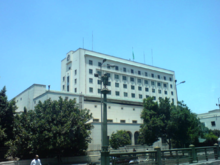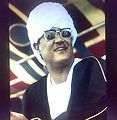League of Arab and Islamic Peoples
The League of Arab and Islamic Peoples ( Arabic جامعة الشعوب العربية والإسلامية Jamiat asch-Schuub al-islamiya al-arabiya , DMG ǧāmiʿat aš-šuʿūb al-islāmīya al-ʿarabīya , English League of Arab and Islamic Peoples , French Ligue des peuples arabes et islamiques ) was the attempt of the Egyptian President Anwar as-Sadat , to establish a counter-organization to the Arab League and the Organization for Islamic Cooperation . The so-called Sadat League existed only from November 1980 to February 1983 and never got beyond the founding phase.
initial situation
Because of the separate peace with Israel ( Camp David Agreement ), Egypt's membership in both the Arab League and the Organization for Islamic Cooperation was suspended in 1979. The Arab League moved its headquarters to Tunis and most of the Arab states (except Sudan, Somalia and Oman) broke off diplomatic relations with Egypt. Some particularly irreconcilable regimes (Libya, Algeria, Syria, VDR Yemen, Iraq) together with the PLO formed the front of steadfastness and rejection of the Egyptian-Israeli peace.
In view of the isolation of Egypt, Sadat took up an earlier concept that was originally intended as an extension of the Arab League to include non-Arab, especially black African Islamic states. In the vacant building of the Arab League in Cairo, the Council of the League of Arab and Islamic Peoples met for its constituent session on November 10, 1980, under Sadat's chairmanship .
Aim and purpose
In addition to the main unofficial goal of breaking Egypt's isolation in the Arab and Islamic world, Sadat's League officially set itself more far-reaching goals, such as: B.
- to face the changed challenges and dangers and to thwart conspiracies by foreign powers
- to promote Arabic and Islamic ideas in the sense of enlightened reform Islam
- to set up an Arab-Islamic Development Bank
In the long term, an economic community based on the model of the EEC should emerge.
Organs and members

The League's 67-member Council of Islamic intellectuals elected Sadat as President of the organization, the Egyptian Minister of Religion Berri as Deputy President and the former Deputy Secretary General of the Arab League, the Egyptian Sayed Nofal , as Secretary General of the newly founded League. The Egyptian Abu Seif Radil became its spokesman. The abandoned headquarters of the Arab League was made available to the league as its headquarters.
An official delegation was only sent by Sudan, with which Egypt had agreed various steps towards the economic, military and political integration of the two states since 1977 ("Unity of the Nile Valley"). Unofficial delegations came to Cairo from Guinea, Nigeria, Oman, Pakistan, Senegal, Somalia and Turkey. League offices should be set up for resistance organizations from Afghanistan, Libya, Syria and the VDR Yemen (South Yemen). In fact, there was only one office for Afghanistan, for which Egypt provided one million Egyptian pounds.
Failure and dissolution
Even after it was soon renamed the League of Islamic Peoples , the organization was unable to compensate for the isolation of Egypt. In addition, it could not find a middle path between reform Islam and increasing fundamentalist Islamization. After Sadat's murder, his successor Husni Mubarak lost interest in the unsuccessful Sadat League. Mubarak placed the reconciliation with the Arab brother states over the League of Islamic Peoples and finally dissolved it on February 28, 1983. In January 1984, Egypt was re-accepted into the Organization for Islamic Cooperation.
Egypt's President Anwar al-Sadat wanted to create a counterpart to the Arab League in 1980
Sudan's President Numeiri supported Sadat during Egypt's isolation
Sadat's successor, Husni Mubarak , dissolved the unsuccessful organization in 1983
literature
- Neue Zürcher Zeitung of October 12, 1980: President Sadat's new league
- Gustav Fochler-Hauke: Der Fischer Weltalmanach 1982 , Fischer Taschenbuch Verlag, Frankfurt (Main), pages 122 and 666f.
- Munzinger Archive / Internationales Handbuch - Zeitarchiv 31/84, page 3 (Egypt Chronicle 1982–84). Ravensburg 1984
Web link
- Der Spiegel 4/1982 of January 25, 1982: What did Syria do for the Golan? (SPIEGEL interview with Hosni Mubarak), online (PDF)



